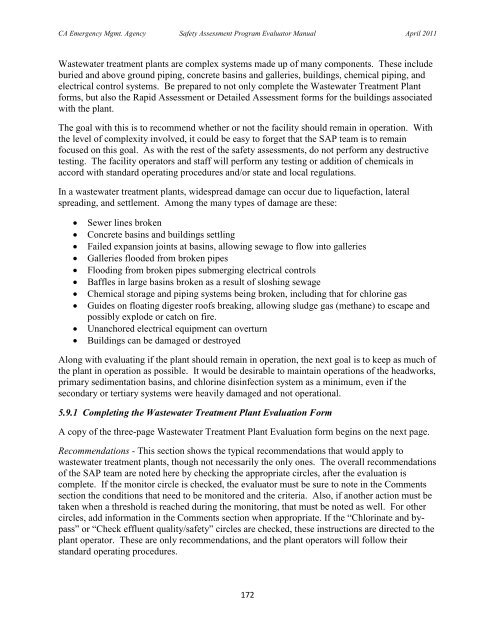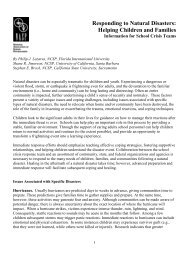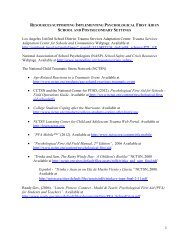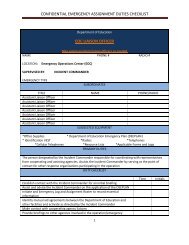Safety Assessment Program Evaluator Student Manual
Safety Assessment Program Evaluator Student Manual
Safety Assessment Program Evaluator Student Manual
Create successful ePaper yourself
Turn your PDF publications into a flip-book with our unique Google optimized e-Paper software.
CA Emergency Mgmt. Agency <strong>Safety</strong> <strong>Assessment</strong> <strong>Program</strong> <strong>Evaluator</strong> <strong>Manual</strong> April 2011Wastewater treatment plants are complex systems made up of many components. These includeburied and above ground piping, concrete basins and galleries, buildings, chemical piping, andelectrical control systems. Be prepared to not only complete the Wastewater Treatment Plantforms, but also the Rapid <strong>Assessment</strong> or Detailed <strong>Assessment</strong> forms for the buildings associatedwith the plant.The goal with this is to recommend whether or not the facility should remain in operation. Withthe level of complexity involved, it could be easy to forget that the SAP team is to remainfocused on this goal. As with the rest of the safety assessments, do not perform any destructivetesting. The facility operators and staff will perform any testing or addition of chemicals inaccord with standard operating procedures and/or state and local regulations.In a wastewater treatment plants, widespread damage can occur due to liquefaction, lateralspreading, and settlement. Among the many types of damage are these:Sewer lines brokenConcrete basins and buildings settlingFailed expansion joints at basins, allowing sewage to flow into galleriesGalleries flooded from broken pipesFlooding from broken pipes submerging electrical controlsBaffles in large basins broken as a result of sloshing sewageChemical storage and piping systems being broken, including that for chlorine gasGuides on floating digester roofs breaking, allowing sludge gas (methane) to escape andpossibly explode or catch on fire.Unanchored electrical equipment can overturnBuildings can be damaged or destroyedAlong with evaluating if the plant should remain in operation, the next goal is to keep as much ofthe plant in operation as possible. It would be desirable to maintain operations of the headworks,primary sedimentation basins, and chlorine disinfection system as a minimum, even if thesecondary or tertiary systems were heavily damaged and not operational.5.9.1 Completing the Wastewater Treatment Plant Evaluation FormA copy of the three-page Wastewater Treatment Plant Evaluation form begins on the next page.Recommendations - This section shows the typical recommendations that would apply towastewater treatment plants, though not necessarily the only ones. The overall recommendationsof the SAP team are noted here by checking the appropriate circles, after the evaluation iscomplete. If the monitor circle is checked, the evaluator must be sure to note in the Commentssection the conditions that need to be monitored and the criteria. Also, if another action must betaken when a threshold is reached during the monitoring, that must be noted as well. For othercircles, add information in the Comments section when appropriate. If the “Chlorinate and bypass”or “Check effluent quality/safety” circles are checked, these instructions are directed to theplant operator. These are only recommendations, and the plant operators will follow theirstandard operating procedures.172
















